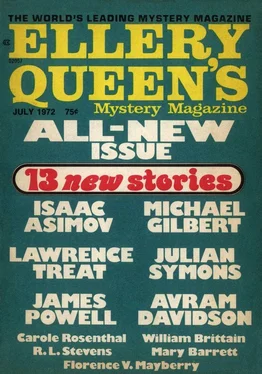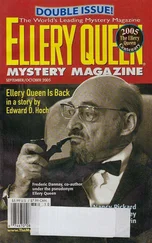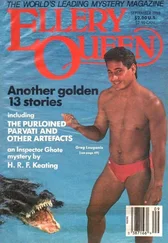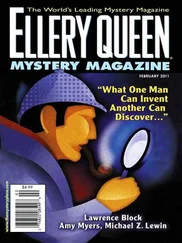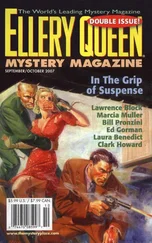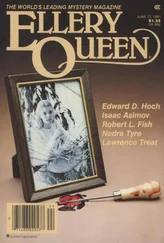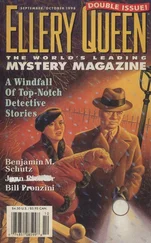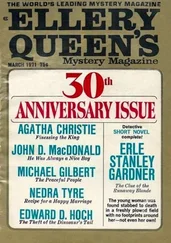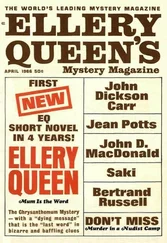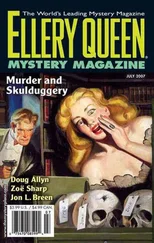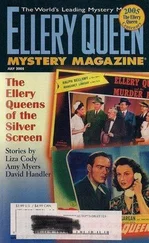Ellery Queen’s Mystery Magazine, Vol. 60, No. 1. Whole No. 344, July 1972
Здесь есть возможность читать онлайн «Ellery Queen’s Mystery Magazine, Vol. 60, No. 1. Whole No. 344, July 1972» весь текст электронной книги совершенно бесплатно (целиком полную версию без сокращений). В некоторых случаях можно слушать аудио, скачать через торрент в формате fb2 и присутствует краткое содержание. Город: New York, Год выпуска: 1972, Издательство: Davis Publications, Жанр: Классический детектив, на английском языке. Описание произведения, (предисловие) а так же отзывы посетителей доступны на портале библиотеки ЛибКат.
- Название:Ellery Queen’s Mystery Magazine, Vol. 60, No. 1. Whole No. 344, July 1972
- Автор:
- Издательство:Davis Publications
- Жанр:
- Год:1972
- Город:New York
- ISBN:нет данных
- Рейтинг книги:4 / 5. Голосов: 1
-
Избранное:Добавить в избранное
- Отзывы:
-
Ваша оценка:
- 80
- 1
- 2
- 3
- 4
- 5
Ellery Queen’s Mystery Magazine, Vol. 60, No. 1. Whole No. 344, July 1972: краткое содержание, описание и аннотация
Предлагаем к чтению аннотацию, описание, краткое содержание или предисловие (зависит от того, что написал сам автор книги «Ellery Queen’s Mystery Magazine, Vol. 60, No. 1. Whole No. 344, July 1972»). Если вы не нашли необходимую информацию о книге — напишите в комментариях, мы постараемся отыскать её.
Ellery Queen’s Mystery Magazine, Vol. 60, No. 1. Whole No. 344, July 1972 — читать онлайн бесплатно полную книгу (весь текст) целиком
Ниже представлен текст книги, разбитый по страницам. Система сохранения места последней прочитанной страницы, позволяет с удобством читать онлайн бесплатно книгу «Ellery Queen’s Mystery Magazine, Vol. 60, No. 1. Whole No. 344, July 1972», без необходимости каждый раз заново искать на чём Вы остановились. Поставьте закладку, и сможете в любой момент перейти на страницу, на которой закончили чтение.
Интервал:
Закладка:
Over the phone at this hour of the night it takes him a minute or so to wake up. When I explain what I want he asks me if I have a color photograph. I say I have one that I took yesterday, but the film is still in my camera.
That’s fine with him. His hobby is photography. He tells me to bring the camera, he’ll develop the film, and he’ll have the duplicate portrait ready within a day or two. I bring him the camera, then go home to bed.
I wake up early and prepare my publicity release. I state that the painting was miraculously saved, that it will be on display later this week. I say that personally I don’t believe any name will appear, that I don’t think the secret of who killed Evelyn Anders is actually in the painting, but that nevertheless we, the museum officials, are watching the portrait closely.
I figure that my announcement will pull in crowds, and I arrange for extra guards to handle the expected mob. But what I don’t foresee is that Rogers will come down on my neck.
He doesn’t call me personally and doesn’t ask when I’ll be in my office. Instead, a police sergeant phones and informs me that Rogers is on his way and I’m to stay put.
He doesn’t bother even to say hello. As he walks through my doorway he’s asking me what the hell the idea is. I tell him I’m running this museum and I don’t have to explain anything to him.
“You’re trying to use a homicide to attract a crowd,” he says. “Suppose I call a press conference this afternoon and expose your publicity stunt and say we have the painting in the lab right now, and that you’re a fraud.”
I give in and tell him about Jacobus, and Rogers does a complete about-face. “I’d like to work with you on that idea,” he says. “But first, I’d better bring you up to date on where the investigation stands.”
According to Rogers, the killer managed to hide somewhere, perhaps in a closet, when the museum was cleared for the night. He waited until about seven o’clock before he went to Gallery 18. Then he took down the painting and began methodically to cut it up. He was doing a good job of shredding it when he heard Dewey approach. The killer probably stepped to one side of the doorway to Gallery 18. When Dewey came through, the killer knifed him without warning. No sign of a struggle. And when Dewey failed to report in at the conclusion of his regular round, the alarm was sounded, but by that time the killer had escaped. Unseen and unheard.
The police had taken the shambles of the painting and laboriously pasted the pieces on a new canvas. The area with the emerging letters was in ribbons, and it was impossible to develop the individual letters. Nevertheless, the laboratory men analyzed the paint scrapings. They are experienced at this — they are constantly analyzing scraps of paint collected from automobile accidents. They did it spectrographically and have discovered that, although the main background of the portrait was a Prussian-blue oil, the area where the letters were beginning to appear was a phthalocyanine blue, which has a tendency to oxidize after a few months of exposure to air. Furthermore, the phthalocyanine letters were painted directly onto the finished canvas, and not over-painted at any later time.
“Then you have St. John cold,” I say. “You’ve spoken to him, haven’t you?”
Rogers shakes his head. “Not yet. He left town this morning, but I’m having him brought back. I expect to talk to him later on today.”
“Well,” I remark, “he’s the only one who could have painted in the name, so it has to be Ewald’s. Right? He wouldn’t paint in his own.”
Again Rogers doesn’t answer. Instead, he asks a question of his own.
“Where is that reproduction of Jacobus’?” he says. “I’d like to see it.”
“It hasn’t come in yet,” I say. “When it does it will have to hang a few days. I can’t exhibit it until the smell of fresh paint goes away. And as for the name, all Jacobus can do is copy the blur that was there yesterday. And believe me, except for that one clear letter, W — it was just a blur.”
Rogers gets up and leaves. I have some outside appointments, so I leave, too, but I can’t get my mind off the Jacobus copy. Suddenly I wonder exactly what that photograph of mine revealed — the one I gave to Jacobus. For camera lenses sometimes bring out what the eye can’t see, and Jacobus undoubtedly reproduced whatever the camera revealed.
I phone my office. Jacobus has delivered the painting and it’s hanging where the old one used to. For some reason that information sets off a train of thought and now, perhaps for the first time, I think the case through, carefully and logically, and I conclude that there is only one person who could have engineered the murders of both Evelyn Anders and Dewey. But how to prove it?
I’m nervous. I think of Dewey last night. I wonder if it can happen again. The killer must have read that the picture will be shown soon. Does the killer believe that the original has been reconstructed, or does the killer suspect a hoax?
I phone my secretary and I order four of the guards to stay on after the museum has closed. I leave instructions for them to patrol in pairs and to be armed. My secretary suggests that we keep the lights on all night, but I veto the suggestion.
I return to the museum about 7:00 p.m. and immediately take a flashlight and head for Gallery 18. I don’t want the guards to know what I’m doing, so I take off my shoes and walk silently. As I go through the deserted rooms I realize that the guards are not too fond of patrolling. I see no one. I have an eerie feeling — the museum has never seemed so deserted, so utterly quiet.
I make the turn into Gallery 18. I see a figure in front of the Anders portrait. An arm is raised, a knife slashes down and glints in the dim light.
Perhaps I make a noise. More likely some sixth sense warns that figure in black. It turns, sees me. For a fraction of a second it hesitates. Then the figure launches itself at me. It leaps like a panther, silent and deadly. I yell, switch on my flashlight, and jump aside. The beam of the light is blinding. I throw the flashlight at the knife and start to run.
My yell has been heard. Somebody turns on the main lights, and the small lithe figure of a woman comes into view. She swerves, she is no longer bent on killing me. She has to escape, but the maze of galleries confuses her; she dashes to the left and finds herself at a dead end.
She whirls and speeds off like a projectile. Three guards are waiting for her. She leaps high — on the stage she seemed to have soared ten, fifteen feet, but it was an illusion. She hurls herself and lands squarely on a burly guard. The knife clatters, and three men grab La Flama and hold her down. She screams at them in Spanish. I turn around, head for my office, and call the police.
Later on I speak to Rogers. “I guessed it was La Flama,” I say, “because of the Dewey murder. He was old and slow, so why kill him when anybody could have easily escaped in the semidarkness knowing that Dewey’s identification would be shaky at best? But there was enough light for him to tell the difference between a man and a woman, and if Dewey had been left alive to identify the vandal as a woman, La Flama was lost. So she had to kill him.
“As for the murder of Evelyn Anders, here was La Flama with fifty million dollars at stake, and Evelyn in the way. La Flama could climb like a monkey. So — kill Evelyn, and Anders would be free to marry.”
Rogers agreed. ‘‘We’ve been looking for La Flama ever since this afternoon, when I spoke to St. John. He told me that Anders had refused to divorce his wife. She wanted a divorce, she wanted to be free of his domination, but he refused because she was his protection against designing women who wanted to marry him for his money. And La Flama was shrewd, designing, and ruthless.
Читать дальшеИнтервал:
Закладка:
Похожие книги на «Ellery Queen’s Mystery Magazine, Vol. 60, No. 1. Whole No. 344, July 1972»
Представляем Вашему вниманию похожие книги на «Ellery Queen’s Mystery Magazine, Vol. 60, No. 1. Whole No. 344, July 1972» списком для выбора. Мы отобрали схожую по названию и смыслу литературу в надежде предоставить читателям больше вариантов отыскать новые, интересные, ещё непрочитанные произведения.
Обсуждение, отзывы о книге «Ellery Queen’s Mystery Magazine, Vol. 60, No. 1. Whole No. 344, July 1972» и просто собственные мнения читателей. Оставьте ваши комментарии, напишите, что Вы думаете о произведении, его смысле или главных героях. Укажите что конкретно понравилось, а что нет, и почему Вы так считаете.
